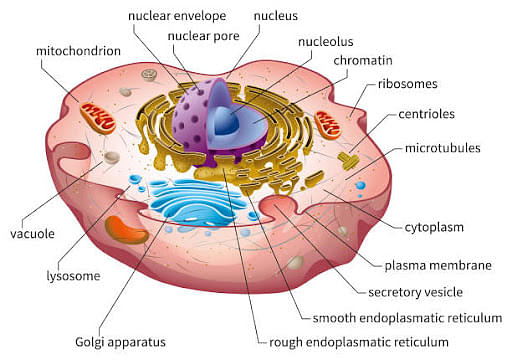A bivalent consists of:
- two chromatids and one centromere
- two chromatids and two centromeres
- four chromatids and two centromeres
- four chromatids and four centromeres.
The Correct Option is C
Approach Solution - 1
A bivalent consist of four chromatids and two centromeres. Bivalent is a pair of homologous chromosome lying together in the zygotene stage of prophase I of first meiotic division.
So, the correct option is (C): four chromatids and two centromeres.
Approach Solution -2
A bivalent denotes a pair of two homologous chromosomes. Although each chromosome consists of two chromatids, there are a total of four chromatids and two centromeres, with each centromere positioned at the center.

So, the correct option is (C): four chromatids and two centromeres.
Top Questions on Cell: the unit of life
- Which organelle is primarily responsible for producing ATP in a cell?
- MHT CET - 2025
- Biology
- Cell: the unit of life
- Which organelle in a eukaryotic cell is primarily responsible for synthesizing proteins destined for secretion?
- MHT CET - 2025
- Biology
- Cell: the unit of life
- Which of the following organisms or organelles contain 70S ribosomes?
- MHT CET - 2025
- Biology
- Cell: the unit of life
- Which term is used for cells performing similar functions and cells collecting intracellular material?
- AIIMS - 2024
- Biology
- Cell: the unit of life
- What is the movement of cytoplasm within a cell called?
- MHT CET - 2024
- Biology
- Cell: the unit of life
Questions Asked in NEET exam
- C(s) + 2H$_2$(g) $\rightarrow$ CH$_4$(g); $\Delta H = -74.8 \, \text{kJ mol}^{-1}$
Which of the following diagrams gives an accurate representation of the above reaction?- NEET (UG) - 2025
- Chemical Kinetics
Predict the major product $ P $ in the following sequence of reactions:
(i) HBr, benzoyl peroxide
(ii) KCN
(iii) Na(Hg), $C_{2}H_{5}OH$- NEET (UG) - 2025
- Organic Chemistry
Consider a water tank shown in the figure. It has one wall at \(x = L\) and can be taken to be very wide in the z direction. When filled with a liquid of surface tension \(S\) and density \( \rho \), the liquid surface makes angle \( \theta_0 \) (\( \theta_0 < < 1 \)) with the x-axis at \(x = L\). If \(y(x)\) is the height of the surface then the equation for \(y(x)\) is: (take \(g\) as the acceleration due to gravity)

- NEET (UG) - 2025
- Surface Tension
- From the statements given below, choose the correct option: (A) The eukaryotic ribosomes are 80S and prokaryotic ribosomes are 70S.
(B) Each ribosome has two sub-units.
(C) The two sub-units of 80S ribosome are 60S and 40S while that of 70S are 50S and 30S.
(D) The two sub-units of 80S ribosome are 60S and 20S and that of 70S are 50S and 20S.
(E) The two sub-units of 80S are 60S and 30S and that of 70S are 50S and 30S.
Choose the correct answer from the options given below:- NEET (UG) - 2025
- Protein Synthesis
AB is a part of an electrical circuit (see figure). The potential difference \(V_A - V_B\), at the instant when current \(i = 2\) A and is increasing at a rate of 1 amp/second is:

- NEET (UG) - 2025
- Electromagnetic Induction and Inductance
Concepts Used:
Cell: The Unit of Life
- A cell is derived as the functional and structural unit of life. Every cell is surrounded by a cell membrane that dissects the external and internal environments of the cell. The interior environment of a cell is called the cytoplasm.
- It carries cellular machinery and structural elements. The nucleus is present in the center of the cell, which includes all the hereditary information of an organism. Some of the molecules present in the cell are protein, carbohydrates, starch, and sugar.
Read More: Fundamental Unit of Life: Cell
Parts of Cell:
The different parts of a cell and their functions are as follows:
- Cell Membrane
- Cell Wall
- Nucleus
- Cytoplasm
